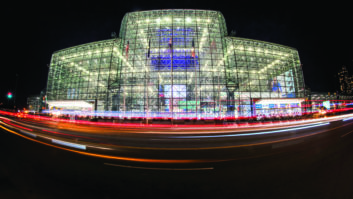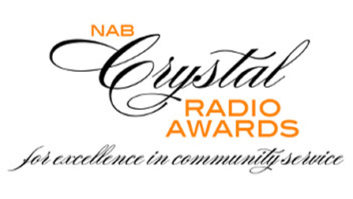Judging at least by the attitude of participants at this year’s National Association of Broadcasters Broadcast Management Conference, radio managers are not cowed or terrified by the recession. Call them concerned.
Certainly they appear to be girding themselves to face whatever the future has to bring, be it further declining revenues, increased competition from new media or the mischief-making meddlings of well-intentioned FCC newbies.
Here’s a sampling of sessions of interest to radio managers. RW previewed technical sessions in the previous issue.
Note that the NAB has combined three former conferences — Radio Management, Television Management and Broadcast Regulatory and Legislative — into one this year: the Broadcast Management Conference.
“We’ve streamlined the conference program by expanding the focus of sessions where there is cross-over appeal to both radio and television,” an NAB official told RW. “We will continue to offer sessions within this conference targeted specifically to either radio or television.”
Who calls the shots?

Jane Mago. ‘We anticipate that a Democratic-majority administration will be looking closely at how broadcasters are serving the public interest.’
Who really has the last word on what goes on air these days; radio broadcasters or the FCC? This thorny topic will be discussed during “Regulating Broadcast Programming — Is Content King or Will Government Reign?” on Monday morning April 20.
“Our panel will focus on how the incoming FCC chairman and the new administration will tackle the myriad of regulatory content issues that face broadcasters, including localism, sponsorship identification/payola, promoting local artists and indecency,” said moderator Jane E. Mago, NAB’s executive vice president and general counsel.
“We anticipate that a Democratic-majority administration will be looking closely at how broadcasters are serving the public interest. We will be talking about what that means to broadcasters going forward and how developments such as HD Radio can enhance that position.”
She noted that broadcasters are speculating about what to expect as the new FCC turns its attention to the radio side of broadcasting, “once the commissioners are seated and we are through the DTV transition.”
Participants are expected from several prominent law firms.
Meet the new boss …

Philippe Patrice. ‘You want your listeners not just to tune to your station via the Web at work, but to have a video window up, keeping an eye on what’s happening.’ Continuing with the spotlight on Washington, wary delegates will be given a road map to “Navigating My Radio Station Through the New FCC” on Monday afternoon, courtesy of moderator Dawn Sciarrino of Sciarrino & Shubert.
“The new FCC is an energetic agency that will ensure that radio broadcasters are indeed both technologically efficient and serving the public interest,” Sciarrino told Radio World.
“We anticipate that the Democratic-led majority will have a keen focus on the future of our industry and technology; and while the new FCC may be supportive of HD Radio, it will likely press for additional public interest requirements from local broadcasters.”
That’s not all delegates should expect from the Obama FCC. Under the new regime, “stations need to be able to juggle serving and growing their local audiences while ensuring full compliance with FCC rules, including EEO, EAS, public file and potentially new enhanced disclosure rules,” she says.
The FCC’s Roy Stewart, senior deputy chief of the Media Bureau, is an invited participant of that panel.
“Reality Radio: Producing Videos for Your Web Site” is a Monday afternoon session that answers the question, “What can radio guys do in video”?
Hosted by executives from StreamThe World — which says it has provided turnkey streaming for 1,000 radio stations — this session will tackle not just how to shoot Web video but what to shoot, including in-studio deejays, live guests and performances and events held away from station property.
“Producing videos for your radio Web site is all about ‘stickiness,” said Philippe Patrice, the company’s product manager. “You want your listeners not just to tune to your station via the Web at work, but to have a video window up, keeping an eye on what’s happening. In this way, you bring them closer to the station and get them more attached to you — and you get a venue for airing commercials at the same time.”
StreamThe World will also offer advice on dealing with deejays who feel that they “only have faces for radio,” comfortable behind the microphone but not on camera.

Erwin Krasnow. ‘Many radio broadcasters look at their [tower] sites as necessary evils. That is a mistake.’ Towers, the undiscovered asset
Love them or hate them, broadcast towers are an essential part of any radio broadcaster’s operation. But what many still do not realize is that towers are valuable pieces of “vertical real estate” that can generate significant revenues, said Erwin Krasnow, owner of Garvey Schubert Barer.
Krasnow is moderating the Tuesday morning session “Vertical Real Estate: Tall Towers Mean Tall Dollars.”
“In some cases, a radio broadcaster’s tower may be of greater value than the underlying station,” Krasnow said.
“However, many radio broadcasters look at their sites as necessary evils. That is a mistake. Tower leasing is a way to capitalize on a constant stream from wireless communications, one of the nation’s fastest-growing sectors of the telecom industry, without interfering or affecting the tower’s original purposes.”
Today, cellular carriers and other wireless service providers are paying $1,000 to $4,000 per month to rent space on broadcast towers, he said.
“The leases, including renewals, are for periods of 25 to 30 years and provide a significant source of continuing and escalating revenue … Leasing space offers several very attractive aspects: Predictable and recurring long-term leasing revenues; low churn rate; high operating margins; continuing demand for towers due to zoning restrictions and environmental regulations; and minimal capital reinvestment requirements.”
Cash-strapped broadcasters can sell their towers for cash, then lease back the space they need from the new owners; however, this money made (and maintenance costs avoided) is offset by the regular cost of leasing this space.
“Most radio broadcasters regard themselves as only being in the radio business,” Krasnow said. “But if they own towers and the ground beneath them, they are also in the real estate business. The session will show radio broadcasters how to turn the ‘steel’ they own into ‘gold.'”
Local market squeeze

Rick Ducey of BIA will discuss the increasing importance of ‘digital’ platforms in the ad mix. Also on Tuesday morning, delegates will focus on making money during “Transforming Radio’s Business Model With Multiple Revenue Streams.”
Moderated by Rick Ducey, chief strategy officer with BIA Advisory Services, the session aims to help broadcasters cope with flat ad revenues by staking turf in multiple media.
“Local ad spend will be decreasing overall through 2013 but growth will occur with digital platforms,” Ducey said. “So radio operators looking for significant growth need to develop strategies for digital platforms and execute on these strategies successfully to grow their businesses.”
The 2008 U.S. local media and advertising market was worth $155.3 billion, an amount Ducey expects to decline. Besides radio, this market includes TV, newspapers, direct mail, Yellow Pages (print), cable TV, magazines and other advertising.
‘Digital’ audiences

Daniel Anstandig. ‘What are you going to give the audience in exchange for their valuable time?’ On Tuesday afternoon following the Radio Luncheon, McVay New Media President Daniel Anstandig will tackle “Digital Audience Growth Strategies” and how radio stations can make money from this sector.
The topic here is not digital transmission; these are the people who spend time interacting with you via your Web site and mobile phone. “This is the audience that regularly accesses your brand beyond your AM or FM signal.”
Broadcasters dismiss this “digital” audience at their peril, Anstandig warns.
“In 2009, the difference between hitting your budget and not hitting your budget will be interactive advertising. This year, $25.7 billion will be spent across the USA in online advertising.”
Those stations who understand the importance of this market are adjusting their sales bonus structures to include interactive audience and revenue benchmarks, and made sure that their programming and promotions include both on-air and online elements.
The change doesn’t end here. In this brave new world of broadcasting, “Program directors have been transformed into brand managers,” he says. “Sellers have been transformed into client solutions specialists, developing marketing plans for their clients that include on-air, online and on-the-go (mobile) components.”
So how does one attract a digital audience? The same way one attracts conventional listeners: through unique and compelling content.
“Without unique content, you have just another radiostation.com or televisionstation.com,” Anstandig says. “What are you going to give the audience in exchange for their valuable time? Your answer to that question determines your value online as well as your ability to translate your interactive efforts into new revenue.”
In formulating an answer, the key is to factor social networking and mobile marketing into the mix. Both are good ways to make direct contact with your digital audience, he says, and to collect listener information that can be “databased” for future sales and promotional campaigns.
“Digital audience is critical in developing future prosperity in radio,” Anstandig said. “2007 was the first year that more advertising dollars were spent on digital media than radio. By 2011, every dollar spent on radio advertising will be equivalent to two dollars spent on online advertising.”
Moreover, “The ad spend projections that are favorable for radio only show minimal growth, while the ad spend projections that are unfavorable for interactive still show 5 percent-plus compound annual growth rate for the industry.
“People are increasingly growing as consumers of digital media.”
Other session topics in the conference include how to build an effective strategic plan; a small-market radio idea swap; and developing your next generation of sales managers.
More information about Broadcast Management Conference sessions can be found at www.nabshow.com/2009/education/bmc.asp.












